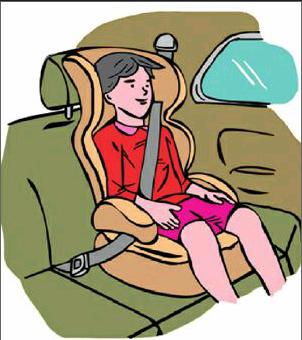Caring More About Child Safety
2014-02-25

A new law on juvenile protection was issued on December 27, 2013, which demands that all car-owning parents install safety seats for their children if they are below the age of 4. The law will take effect in March 2014. Parents, guardians or relatives have to install the safety seat before taking children out in their cars. All children below 12 years old must also sit in the back seats.
According to statistics from the Chinese Academy of Social Sciences, more than 18,500 children under 14 die in traffic accidents in China every year and 75 percent of the accidents involve private cars. Only 5 percent of the population in China uses child car seats, compared to nearly 95 percent in the EU. As a result, the fatality rate of children involved in car accidents in China is 2.5 times that in Europe.
Safety seats for children are able to drastically reduce the fatality rate of children in car accidents, and are considered the most important protective measure for traffic accidents. In this light, Shanghais issuing of this new law demanding parents install car safety seats for children has aroused a new round of discussions on the use of safety seats in China. The following are excerpts of opinions:
Yu Guo (Southern Metropolis Daily): What has led to the high fatality rate for children in traffic accidents? To a large extent, it could be blamed on parents poor understanding and driving habits. Parents tend to put their children in the front passenger seat, and many of them believe that this is the safest place in a car for their children, as there are airbags and safety belts, and also because its easy for parents to take care of their children on this seat.
However, their trust in the front passenger seat is groundless. A number of experiments reveal that airbags and safety belts, which are designed for adults, will often be responsible for the death of children in traffic accidents.
Bearing this in mind, the issuing of the law in Shanghai is significant. This local legislation sets out to correct the habits of many parents. Such laws have long been established in many others countries. Shanghais latest legislation can act as a reference for many other places in China in the future.
Meanwhile, although many laws and regulations intend the best, in practice such measures may end up failing. What will come from this new law? In order to ensure smooth implementation of the law, there must be supervision and punishment. With such a large number of families possessing private cars in China and the traffic conditions in most cities, it is nearly impossible to examine whether every car is acting in accordance with the regulations. Therefore, to what extent the new law will be effective remains in question.endprint
Nanchen (Xinhua Daily Telegraph): Although this is only local legislation and lacks any penalty, it will raise peoples awareness of car safety, and hopefully the example will be followed by more places around the country.
More and more Chinese families now own cars, but according to an investigation by the Ministry of Public Security, only a small portion of these families provide proper safety restraints for their children.
In many accidents, children held by adults in the front seat are hurt by debris or smashed into the windshield and die as a result. Mostly, it is because parents dont know how to use safety seats for their children, as they havent been educated about the necessity. Another important factor is that Chinas legislation on car safety for children is still far behind many other countries.
Jiang Yunhua (Beijing Times): Parents are blamed for their poor understanding of safety and the government for its lack of su-pervision and legislative actions.
As far as child safety seats are concerned, automakers also have a responsibility. They are obligated to tell buyers what kind of anchorage system fits in their cars. Automakers and sellers enthusiastically tell consumers their cars have airbags, but they seldom tell consumers whether their cars have an anchorage system for child safety seats, or what criteria these anchorage systems fit. As child safety seats are not as much of a focus in the Chinese auto market, to save on manufacturing costs, some transnational automakers have even decided to not install anchorage systems. Of course, some buyers have no plan to use this system anyway, thus perpetuating the vicious cycle.
We hope that automakers and sellers will provide detailed safety information and more literature on seat belt anchorage systems. In this way, mothers will no longer feel puzzled about what kind of safety seats they should buy for their children and fathers will no longer feel frustrated while trying to install safety seats.
Luo Yu (jx.zjol.com.cn): Every year, lots of children die in traffic accidents, and many of these tragedies occur because child safety seats are not properly installed or are not used at all. As more and more families buy private cars, its time to pay more attention to the safety of children.
Parents tend to let the child sit alone in the front passenger seat, or leave the child alone in the back of the car without any safety restraints, have the child held in an adults lap, or have the child use an adults safety belt. All of these can potentially add elements of danger for a child in a car.endprint
In the 1970s, Western countries began to research safety devices for children in cars. It was later found that special safety devices for children in cars will help to reduce injury by about 70 percent, and child safety seats play a key role in protecting children in case of traffic accidents.
Since 1999, automakers have been required to put child restraint systems in cars in the United States. There are more than 25 million child safety seats in the United States, compared to only 600,000 in China. Today, more than 40 countries in the world have already issued relevant legal regulations, making it compulsory that children sit in safety seats. In Germany, the Netherlands and Japan, children under 12 years old are required to sit in child safety seats.
Its unfortunate that there are so many loopholes in Chinas current laws and criteria concerning childrens restraint in cars. Even now, Chinas first mandatory national standard on childrens car safety—ISOFIX—has not been put into practice yet. Many parents do not pay attention to the ability to install child safety seats when choosing a car to buy. Parents are given little education on childrens safety when taking classes at driving schools.
China is a manufacturing base for child safety seats, but the domestic market is still limited. As a result, while we export our products to other countries, our own children in China are rarely provided with safety seats for various reasons. We hope this situation will be improved. nendprint
